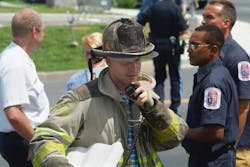As fire departments assume an increasing role in providing emergency medical services, we have become familiar with the term “the golden hour.” The concept suggests that the first 60 minutes of an incident are critical to a patient’s survival.
It stands to reason that a similar window exists for successful firefighting operations, particular because, according to Underwriters Laboratories (UL), the time that’s available to escape a residential fire has decreased by more than 75 percent because of the highly flammable materials that are found in today’s homes.
The actions that are taken—or not taken—during the first golden minutes of an alarm play a key role in the outcome of the incident. None of these tasks are initiated or completed without successful communication.
Close the loop
An investigative report that was issued by Howard County, MD, in 2019 after the loss of one of their firefighters cited the need for a “closed loop” system of radio transmissions. In short, it recommended that receivers acknowledge messages that were sent. This isn’t the first time the observation appeared in similar summaries.
Dispatch is where the need for accuracy and consistency begins. The appropriate type and location of the emergency, along with the presence of victims and hazards, must be broadcast and assigned to the proper units. It’s imperative that all critical messages are acknowledged, particularly in instances in which mobile data terminals are used, because information can be lost easily when one simply reads from a screen. The importance of dispatch/responder communication was highlighted in a call that involved a civilian fatality in Polk County, FL, in 2018, and procedures there have been subsequently upgraded.
Most of us have heard the old story about the car fire being in the garage, and the garage being in the basement. In the real world, these details make a difference, as does being dispatched to the correct location. On Feb. 24, 2019, responders in Beaufort County, SC, were sent to the wrong bridge for a deadly boating accident. The report was received from a cellphone on the water. Although technology is improving, wireless devices don’t provide a dispatchable address all of the time. Because such 9-1-1 calls are directed to the closest cell tower, they aren’t routed automatically to the proper agency. Even when they are, no data are provided regarding floor or room number.
Good standard operating procedures include advisement of what units/departments have been assigned, particularly if routes of travel potentially conflict. It’s critical to identify steps to take if no response is received after a specified time. This can include re-alerting, using alternate means of contact, dispatching the next due rig or mutual aid.
Acknowledgement and response go hand in hand, so dispatched units must confirm their receipt of their assignment and their availability to respond. This can be accomplished in numerous ways, but by voice and by mobile data terminals are most common. In some areas, the number of crew members who are aboard the apparatus becomes part of this confirmation. In career departments, staffing typically is predetermined. In volunteer organizations, it’s important for the incident commander (IC) to quickly assess the personnel resources that are available. Some departments issue radios to a number of members to provide expedited intelligence. The firefighter closest to the scene typically responds and provides an initial size-up, because officers might be several miles away. Regardless of the system that’s used, it’s important to designate who should talk to whom and how and when they should talk. Listening to some emergency communications can give the impression that radio waves, and not water, are being used to suppress the fire. If you ever had the urge to shout, “Put down the hand-held radio and pick up a hose,” some policy review and training might be in order.
An unfortunate side effect of modern trunked radio systems is caused by the abundance of channels. Talk groups often are created for every imaginable purpose. Although this allows for unimpeded discussion, it can do so at the expense of brevity and increase the risk that everyone won’t be on the right frequency. In the Howard County line-of-duty death (LODD), the victim firefighter was reportedly on an unmonitored channel—one of 93 talk groups from which he had to choose. Many departments place mayday talk groups on universal channels at the highest and lowest positions programmed: No matter which direction the knob is twisted, when it stops, it will be on a frequency to which someone is listening.
The advent of mobile data terminals and the Global Positioning System has lessened the need for broadcasting detailed routing information, but these devices aren’t universal, and a number of apparatus still lack this technology. In those instances, or where interruptions to response routes occur in real time, related information should be passed along to all units by radio. Even where computer-aided dispatch allows for the identification of street closures to be programmed, it still is a good idea to make a verbal announcement. Accidents, blocked crossings, flooding or any hazards that could impede safe travel should be broadcast to all similarly. In some areas, it also is customary for responding apparatus to give their location when approaching intersections of common travel. The use of full unit identifiers on all transmissions and refusing to accept microphone clicks as acknowledgments, again, are two very basic, yet very significant, principles. If it’s important enough to say, it’s important enough to ensure that the intended parties received and understood the message.Information exchange
Updates to facts that are critical to life safety need to be continuously exchanged. Whether provided to dispatch through follow-up phone calls or discovered by firefighters upon arrival, these must be broadcast to and acknowledged by all units and personnel. Unfortunately, acts of aggression increasingly are added to this list, with information about active shooters or known belligerents included here. The lack of unified command, incompatible communications systems and disparate dispatch centers that handle pieces, but not all, of the puzzle can slow this exchange. Examinations of the Pulse nightclub shooting, the Parkland High School incident, and even the World Trade Center collapse reveal the effect of such shortcomings. Unfortunately, it doesn’t have to be an event that garners international attention for poor procedures or workflow to compromise operations. Faulty communications can affect even a room-and-contents fire adversely.
Water sources need to be identified, and information on their location needs to be relayed to engine companies. Whether selection occurs through manual observation, computers or map books, clear instructions should be given concerning the responsibilities of individual units in securing a reliable supply. A size-up must be made, with the appropriate details broadcast. It isn’t the intent of this article to enumerate the contents of this transmission, other than to reinforce the need for it to be thorough and to be based on a 360-degree evaluation of the scene. Failure to complete and share an adequate size-up has been cited in LODD events, including a residential flashover in Homewood, IL. Besides serving as a heads-up for all responders, the size-up can alert the communications center to developing needs. Just as firefighters understand the differences in their assignments between a working fire and food on the stove, so, too, can dispatchers prepare for escalation. Additional alarms, utility shutoffs and EMS response might be anticipated based on size-up information.
When making a formal request, it’s imperative that the reason be clearly stated. Which utility must be cut? Is it for general safety or an immediate danger? Is EMS needed as a precautionary standby or to render aid? If the latter, how many victims are there, and what is the nature of their injuries? Is the call for law enforcement simply for traffic control, or are firefighters under duress? All of these make a difference in the type and priority of assistance that’s sent. Unfortunately, first responders often neglect providing information on why they need help. Although appreciative of having information to support their own responses, they often forget this requirement when it comes to others, simply ordering telecommunicators to “get them here right away,” without further detail.
The most common methods of communication involve public safety networks. Whether computerized or voice, they account for the majority of information that’s exchanged during dispatch and response. It should be recognized, however, that personal contact, such as passing along messages face to face, also play a part. Cellphones are an increasingly popular way to communicate, and they have made their presence known in the fire service as valuable tools. Smartphone apps can be used to track volunteer responses and to check hazmat databases.
Although availability plays a large part in determining which method of communication to use, the suitability for the task at hand should be considered. When privacy is an issue, wireless devices are relatively secure compared to unencrypted radios, but wireless devices are less desirable for sharing information to a large group in real time. Although first responders can acquire priority ranking on these networks, disasters can quickly place demands on bandwidth. Further, many cell towers have little or no backup power, which means that they could fail when they are needed most. Also, alternate or personal means of communications can complicate after the fact because of the lack of recording of conversations and the legal processes to secure audit trails of records.
Maydays missed!
Key communications continue after the size-up is in place and apparatus is properly positioned. Each crew must understand their assignment and clearly relay their compliance and location to the IC. Where multiple divisions or sectors are involved, this chain of command might become more complex. Regardless of the magnitude of the event, personnel accountability must be centrally maintained. Progress reports should be made periodically, and as needed, particularly when they involve firefighter well-being. The location of victims or outright distress calls top this list, but there are clues within the tone and content of many transmissions that indicate trouble is brewing. Over a period of about three years, Project Mayday studied almost 3,000 recordings and identified a number of key phrases that were broadcast prior to the official declarations. Included were, “We are running out of air,” “We have had a flashover” and “We have fire above our heads.” (A complete list can be found at firehouse.com/12387578.)
Perhaps more troubling are other findings from this research. According to Project Mayday’s report, “The project found that in 87 percent of maydays, there is a major breakdown in communications, orders issued or received, missed messages, walk-over communications and, the worst of problems, missing a mayday call the first time (54 percent of mayday calls are missed).” To provide an extra set of ears, NFPA 1221: Standard for the Installation, Maintenance, and Use of Emergency Services Communications Systems states, “When requested by the incident commander, a telecommunicator shall be dedicated to the incident and relieved of other duties in the communications center.” Although designed to augment on-scene reception via an additional off-site monitor, messages that are missed at the scene still might go unheard at dispatch. This was pointed out during the Hackensack Ford fire of 1988. Dispatchers were alerted to critical communications by a caller who overheard the firefighters’ requests for assistance on a scanner.
More importantly, the current chronic nationwide shortage of dispatchers makes such dedicated assignments problematic. Although the standard mandates such action, reality often precludes it when there are scarcely enough people in the dispatch center to answer incoming calls.
The declaration of a mayday might be the most critical fireground communication that’s ever made. A comprehensive written policy that’s understood by every member must be in place, and this understanding must include all mutual-aid firefighters who are on scene. How and when to call the mayday, what channels to use and the operation of emergency buttons, where provided, all need to be addressed. Keep in mind that the functionality of trunked radios isn’t universal and that talk group selection and microphone control during emergencies are among the parameters programmed locally. Members must know what to expect should an activation be necessary. Radio response to maydays is an aspect that must be trained, particularly when every firefighter is equipped with a portable radio. Although the desire to help those who are in need is commendable, any mayday should immediately clear the channel, with priority given to messages between those who need assistance, the IC and those who are assigned officially to intervene. Numerous unsupervised transmissions can interfere with calls to and from these key players.A good start
Basic communications practices prove invaluable to your success no matter when they occur. Periodic updates of progress should be given, and critical times, such as first water and under control, should be noted. Timers that remind ICs of on-scene personnel commitments are helpful, particularly during interior or hazmat operations. As we move further into the realm of plain speech, we need to ensure that our words are understood. Although 10 codes weren’t universal, they were clear to the agency that used them and saved airtime. One only needs to witness the discussion of tanker versus tender or ask for a description of “fully involved” to comprehend the dilemma. Plain text aside, much can be gained for circuit discipline. Is what you have to say important? Will it have an effect on safety or operations? If the answer to either question is no, perhaps it can be left unsaid. In addition to limiting dialog, it also is extremely important that the right messages always get to the right people. Conversely, if you have an emergency, say so. During periods of high demand, such as disasters, severe weather and brush/wildfire season, dispatchers can be inundated with radio traffic. Letting them know you need immediate assistance helps move you to the front of the line.
Again, regarding the expansion of channels, or talk groups, that’s associated with trunked radio systems: One issue that has arisen is that alerting still might occur on very high frequencies, while operations are carried out on 800 MHz. Although this segregation of activities eliminates the competition between tone and voice during the initial stages of firefighting, it means that updates from the scene won’t be heard on pagers. This ability for a firefighter to monitor while responding in his/her personal vehicle can be addressed through simulcasting or by re-paging critical status changes.
Aristotle said, “The beginning seems to be more than half of the whole,” and this principle applies to our actions and communications during dispatch, response, arrival, size-up and initial attack. Good practices should be used all of the time, but they are needed in particular during the formative stages of an incident. Communications during the first golden minutes truly do set the tone for success.
Ten Keys to Successful Incident Communications
- Dispatch should ensure that the proper units are assigned to the correct address and incident type, on time, every time.
- Verification should be received and confirmed that all designated units are en route. Stations should be re-toned and/or alternate resources assigned if primary units fail to respond.
- Critical information, such as victims and hazards, should be broadcast to, and acknowledged by, all responding resources.
- The first unit on scene should establish incident command, and so identify. Future transfers of command should be broadcast and acknowledged. NIMS/ICS compliance should be maintained throughout.
- A 360-degree size-up must be completed, and the results must be transmitted.
- Upon arrival, fireground resources must be assigned, and tasks must be verified. Make sure that you are on the right channel. Accountability is key.
- Continuous updates of critical information should be provided throughout the incident timeline, particularly those that affect life safety. If you see a problem, let others know.
- Basic radio principles need to be consistently followed, including the use of full unit identifiers and approved phonetics. Listen before you transmit. Microphone clicks aren’t acknowledgements.
- Be direct and specific in your orders or requests. Plain text isn’t always so plain. Make sure your questions and your needs are fully understood. If you have an emergency, say so.
- Create, codify and maintain communications standard operating procedures. Conduct regularly scheduled communications drills that cover not only daily operations but also special cases, such as maydays and equipment failures.
About the Author

Barry Furey
BARRY FUREY, who is a Firehouse Contributing Editor, provides consulting and training services in emergency communications. He is the former director of the Raleigh-Wake Emergency Communications Center in North Carolina. During his 50-year public safety career, he has managed 9-1-1 centers and served as a volunteer fire officer in three other states. In 2005, Furey received a life membership in the Association of Public-Safety Communications Officials (APCO) International for his continued work in emergency communications. Furey was inducted into the Firehouse Hall of Fame in 2017.


